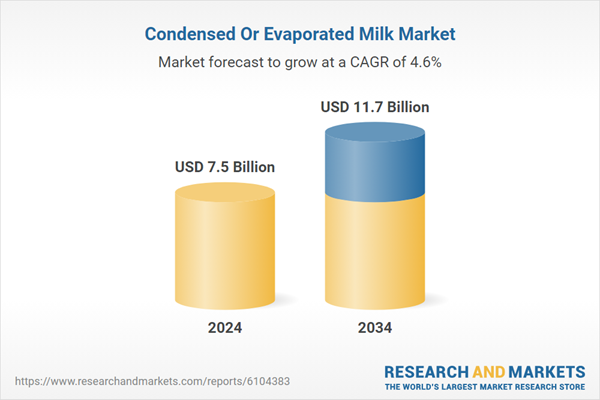Additionally, shifting food trends have sparked renewed interest in recipes incorporating condensed milk, especially across Asia-Pacific and Latin America, fueled by the growth of convenience foods and ready-to-eat desserts. Innovations such as new flavors, low-sugar options, and plant-based or lactose-free alternatives are broadening the product’s appeal. Enhanced packaging solutions and expanded online retail availability are improving access and convenience, supporting steady market expansion amid competition from fresh and non-dairy milk products. The market remains robust as modern and traditional diets evolve in both developed and emerging regions.
In 2024, sweetened condensed milk accounted for a 35.2% share, valued at USD 2.6 billion. This segment continues to thrive due to focused marketing efforts and product innovation that align with consumer preferences. While unflavored condensed milk retains significant popularity for cooking applications, flavored variants - such as those with chocolate, caramel, or vanilla - are gaining traction, especially among younger consumers seeking indulgent treats.
The canned packaging segment held a 31.5% share in 2024 and is projected to grow at a 4% CAGR, expanding its consumer reach. Although cans remain the dominant packaging choice for evaporated milk due to their durability and ability to maintain product freshness, their heavier weight and higher production costs mean growth is steady rather than rapid. Meanwhile, Tetra Pak cartons using aseptic technology are becoming more popular because they are lightweight, recyclable, and preserve milk without refrigeration, appealing to environmentally conscious consumers.
Europe Condensed or Evaporated Milk Market held a 34.3% share in 2024. Regional consumption patterns and culinary traditions heavily influence market dynamics. The European market maintains steady demand driven by the widespread use of evaporated milk in cooking and processed foods. North America represents a mature market with steady growth, largely fueled by the baking and convenience food sectors. In contrast, the Asia-Pacific region is experiencing rapid expansion, propelled by urbanization, changing eating habits, and increased demand for Western-style desserts and beverages that use these dairy products.
Key players in the Global Condensed or Evaporated Milk Industry include Friesland Campina N.V., Arla Foods, Danone S.A., Nestlé S.A., and The J.M. Smucker Company (Eagle Brand). To strengthen their position in the condensed or evaporated milk market, companies are focusing on product innovation and expanding flavor varieties to meet diverse consumer tastes. Emphasis on developing low-sugar, plant-based, and lactose-free options addresses growing health and dietary concerns.
Firms are investing in sustainable packaging solutions, such as recyclable cartons and lightweight containers, to align with environmental goals and consumer preferences. Strategic expansion of online sales channels improves product accessibility in regions with limited refrigeration. Additionally, partnerships with food service providers and retailers help broaden market reach.
Comprehensive Market Analysis and Forecast
- Industry trends, key growth drivers, challenges, future opportunities, and regulatory landscape
- Competitive landscape with Porter’s Five Forces and PESTEL analysis
- Market size, segmentation, and regional forecasts
- In-depth company profiles, business strategies, financial insights, and SWOT analysis
This product will be delivered within 2-4 business days.
Table of Contents
COMPANIES MENTIONED
The companies featured in this condensed or evaporated milk market report include:- Nestlé S.A.
- The J.M. Smucker Company (Eagle Brand)
- Arla Foods amba
- FrieslandCampina N.V.
- Goya Foods, Inc.
- Dairy Farmers of America, Inc.
- Borden Dairy Company
- Fonterra Co-operative Group Limited
- Danone S.A.
- Amul (Gujarat Cooperative Milk Marketing Federation Ltd.)
- California Dairies, Inc.
- Almarai Company
- Saputo Inc.
- Alaska Milk Corporation (Royal FrieslandCampina)
Table Information
| Report Attribute | Details |
|---|---|
| No. of Pages | 220 |
| Published | June 2025 |
| Forecast Period | 2024 - 2034 |
| Estimated Market Value ( USD | $ 7.5 Billion |
| Forecasted Market Value ( USD | $ 11.7 Billion |
| Compound Annual Growth Rate | 4.6% |
| Regions Covered | Global |
| No. of Companies Mentioned | 15 |









